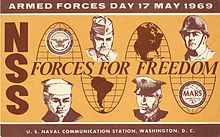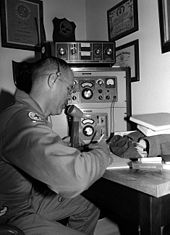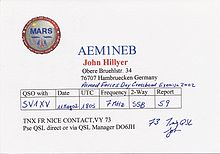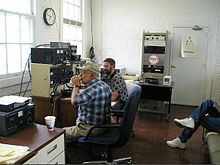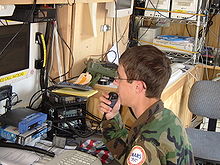- Military Auxiliary Radio System
-
Military Auxiliary Radio System 
Abbreviation MARS Motto "Proud, Professional, and Ready" Formation November, 1948 Purpose/focus Emergency and auxiliary communications support for the United States Armed Forces Region served Worldwide The Military Auxiliary Radio System (MARS) is a United States Department of Defense sponsored program, established as a separately managed and operated program by the United States Army, Navy, and Air Force. The program is a civilian auxiliary consisting primarily of licensed amateur radio operators who are interested in assisting the military with communications on a local, national, and international basis as an adjunct to normal communications. The MARS programs also include active duty, reserve, and National Guard units; Navy, Marine Corps, and National Oceanic and Atmospheric Administration ships, and Coast Guard cutters and shore stations.[1]
MARS has a long history of providing worldwide auxiliary emergency communications during times of need. The combined three-service MARS programs (Army, Air Force, and Navy–Marine Corps) volunteer force of over 5,000 dedicated and skilled amateur radio operators provide the backbone of the MARS program. The main benefit of MARS membership is enjoying the amateur radio hobby through an ever-expanding horizon of MARS service to the nation. MARS members work by the slogan "Proudly serving those who serve".
Contents
History
The organization that led to the Military Auxiliary Radio System was called the Auxiliary Amateur Radio System (AARS). AARS was created in November 1925 by a few dedicated pioneers in the United States Army Signal Corps led by Captain Thomas C. Rives. His original intent was to enlist the talents of volunteer amateur radio operators as a ready source who could train soldiers in the then new technology of radio, as well as pursuing radio research and development to improve radio equipment within the Army. In addition, this support would be particularly useful during the mobilization of forces by providing a pool of already trained radio operators. Their efforts were very successful, and the present-day MARS program is the direct descendant of the work of those early pioneers.
Between 1925 and 1941, the AARS continued to operate and functioned more or less as an extracurricular activity for members of the Army Signal Corps, with its scope limited by budget cuts during the Great Depression. The AARS organization continued to operate until the United States entry into World War II on 7 December 1941, at which time radio amateurs were denied the use of the airwaves; both the amateur service and the Army Amateur Radio System were deactivated. Following World War II, the U.S. Army recognized the great importance of reactivating the AARS to train vitally needed communications personnel at a relatively low direct cost to the government, and in 1946 the AARS was reactivated.
MARS Operator at Marine Corps Logistics Base Albany, 1983.
The AARS functioned as such until the creation of the Military Amateur Radio System in November 1948 with the establishment of separate Army and Air Force MARS programs, reflecting the creation of the Air Force as a separate service. The program's name was changed to the Military Affiliate Radio System on 2 September 1952, in recognition of the organization's changing nature with the growing number of civilian volunteer members. Eventually, the Navy-Marine Corps MARS program was established officially on 17 August 1962, and began operations on 1 January 1963. This followed on the heels of the Cuban Missile Crisis and President Kennedy's concern for viable and extended communications capabilities.
During the Korean War, Vietnam War and Gulf War, MARS was most known for its handling of "Marsgram" written messages and providing "phone patches" to allow overseas servicemen to contact their families at home.
The program's name was changed again to the current Military Auxiliary Radio System on 23 December 2009.
MARS continues to be very active today. Its primary mission is providing auxiliary to the US Military and emergency communications to such National agencies as FEMA and Homeland Security. MARS is also available to assist state, and local emergency response agencies; both public and select private agencies, such as the Red Cross.
On a day-to-day basis MARS members are available to handle messages to and from service men and women: active duty, reserve, guard, or retired and certain employees of the federal government who are stationed outside the U.S.
Missions
Military Auxiliary Radio System provides Department of Defense sponsored emergency communications on a local, national, and international basis. MARS also provides auxiliary communications for military, federal, civil, and/or disaster officials during periods of emergency. They assist the military and other organizations in effecting normal communications under emergency conditions. One major mission that MARS has had for many years is to handle morale, welfare, and official record and voice communications traffic for Armed Forces and authorized U.S. Government civilian personnel stationed throughout the world. MARS establishes programs to create civilian interest, recruit qualified volunteers, and furnish training in military communications, techniques, and procedures.
Every year, MARS conducts an appropriate military and amateur radio cross-band exercise as an integral part of the annual Armed Forces Day. They provide a reserve of personnel trained in military radio communications, techniques, and procedures as well as to initiate efforts to improve radio-operating techniques. MARS members test state-of-the-art technology through experimentation and testing.
Armed Forces Day Crossband Test
MARS celebrates Armed Forces Day annually with a traditional military to amateur crossband communications test and a message-receiving test. These tests give amateur radio operators and shortwave listeners an opportunity to demonstrate their individual technical skills and receive recognition from the Secretary of Defense or the appropriate military radio station for their proven expertise. A QSL card is provided to those making contact with one of the military stations. Special commemorative certificates are awarded to anyone who receives and accurately copies the digital Armed Forces Day message from the Secretary of Defense.
Participating military stations transmit on selected military MARS frequencies and listen for amateur radio stations in the amateur bands. The military station operator will announce the specific amateur-band frequency being monitored. Usually, the military MARS stations are at places such as Fort Detrick, Fort Huachuca, Andrews Air Force Base, and Nellis Air Force Base.
MARS Today
MARS Operator, AAT3OT, using a radio to communicate with the U.S. Army Reserve in the MARS Emergency Communications Unit trailer.
The Military Auxiliary Radio System is still active today. Morale and welfare messages are no longer the largest activity in MARS due to the increased use of the Internet and e-mail by deployed military personnel. MARS now has an increased role in providing interoperability communications between Army National Guard and Air National Guard forces and civilian state agencies. MARS also provides beta testing of new technologies such as Voice over Internet Protocol and antennas.
MARS Operators erecting an HF antenna at Fort Meade for Grecian Firebolt 2005.
MARS participates in exercises such as Grecian Firebolt to help support military communications. MARS members from all around the world played a role in Grecian Firebolt 2005 by sending exercise Essential Elements of Information (EEI) reports through the MARS radio network. The EEI's consisted of scenario disaster information. When the EEI's were received, they were sorted and sent to Army Military Intelligence centers. MARS plays a large part in reporting up-to-date information on disasters and requesting military assistance using a dispersed and redundant radio network.
MARS also supports government agencies such as the Federal Emergency Management Agency, and participates in programs such as SHAred RESources (SHARES).
The traditional land or sea based MARS Radio Phone Patch is largely a thing of the past because land and sea based MARS stations have been dismantled in favor of Satellite Phones. However, modern military aircraft are still equipped with HF radios, and many military aircrews still use MARS Phone Patches as a backup or substitute to Satellite Communications. The USAF MARS Phone Patch Net provides 24/7 HF Radio Phone Patch service to all branches of United States military aircraft worldwide.
A dispatch issued in May 2009 announced the possible shutdown of the Navy and Marine Corps MARS program by September 30, 2009.[2]
Department of Defense Instruction 4650.02, dated 23 December 2009 changed the status of MARS from an affiliate to an auxiliary (equal in status to the Coast Guard Auxiliary and Civil Air Patrol). This change in status saved the Navy-Marine Corps MARS program from being shut down and put it back in line with the Emergency Communications mission of its sister services (Army and Air Force MARS).
Customers
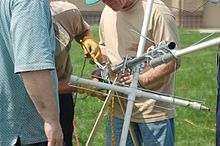 Members of the then Military Affiliate Radio System (MARS) prep an antenna on 10 May 2007 as they respond to a simulated nuclear incident during Operation Vigilant Guard, a joint military and civilian training exercise under way at Camp Atterbury, near Edinburgh, Indiana
Members of the then Military Affiliate Radio System (MARS) prep an antenna on 10 May 2007 as they respond to a simulated nuclear incident during Operation Vigilant Guard, a joint military and civilian training exercise under way at Camp Atterbury, near Edinburgh, Indiana
- Department of Defense
- Department of the Army
- Department of the Air Force
- Department of the Navy
- Joint Director of Military Support (JDOMS)
- Department of Homeland Security
- Department of State
Notes
- ^ R.D. Straw, N6BV, ed (2006). The ARRL handbook for radio communications (38 ed.). Newington, CT: ARRL. pp. 2.5. ISBN 0-87259-948-5.
- ^ Richard Fisher, KI6SN (August 2009). "Sunset for Navy MARS? Specter of shutting down mission raises questions, speculation". CQ Amateur Radio 65 (8): 46. ISSN 0007-893X.
- ^ NavyMARS.org website
References
External links
- U.S. Army MARS
- U.S. Navy-Marine Corps MARS (USN, USMC & USCG)
- U.S. Air Force Network Integration Center
- U.S. MARS Links
- Canadian Forces Affiliate Radio System
- FEMA Region 6 and Texas Army MARS
Inter-service: Military Auxiliary Radio System (MARS)Categories:- Amateur radio organizations
- Auxiliary military units
- United States Department of Defense
- Department of Defense
Wikimedia Foundation. 2010.

